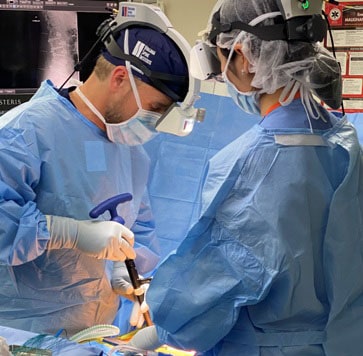
As featured in The Spine Health Journal: VSI Pioneering Augmented Reality in Spine Surgery
Two spine surgeons in Virginia performed some of the first spine surgeries using Augmented Reality (AR) in history. In October 2020, Dr. Christopher R. Good was the first person to perform surgery using AR in the entire DC and Virginia area. Later, in November 2020, Dr. Ehsan Jazini performed the world’s first laminectomy with AR. Dr. Good and Dr. Jazini are both members of the National Spine Health Foundation‘s Medical & Scientific Board. Our team spoke with them to learn more about the surgeries and what it is like to pioneer this rapidly growing technology.
- Does Augmented Reality (AR) increase your confidence in the success of a surgical procedure?
The success of a surgical procedure is measured by accomplishing the goals of surgery in the safest way possible. I believe there is a strong patient interest and demand for this type of technology as we continue to push to make our surgeries safer and less invasive for patients.
AR technology allows me to see the patient’s detailed 3D anatomy without having to look up. This allows for better precision and accuracy as well as smaller incisions. What this means for my patient is faster recovery and less pain from surgery.
- What do you want a patient, who may be intimidated by the idea of AR surgery, to know?
Christopher R. Good, MD
It is important for patients to understand that Augmented Reality does not take the place of a human surgeon performing the operation. To use AR during spine surgery, we wear special goggles that let us look at our patient while viewing a hologram of the patient’s bones at the same time. The headset shows us the position of our surgical tools and superimposes them on the hologram so we don’t have to take our eyes off of the patient to view a screen while we are operating. It’s like having “x-ray vision.” This is similar to the heads-up display used by fighter pilots to allow them to see critical flight information while they are also looking out the window to fly.
Ehsan Jazini, MD
I want them to know that this technology takes the existing navigational technology that has been used for more than 10 years and brings it to the surgeon like a “heads up display in your car windshield” so that the surgeon can stay focused on what is most important, the patient. This leads to a safer and more precise job and faster recovery for the patient while minimizing potential complications.
- Based on the unique AR “first” each of you performed, describe your reaction to being a spine surgery technological pioneer? What did you learn by being the firsts?
Christopher R. Good, MD
The surgeons at the VSI are proud to be leading the way in utilizing this revolutionary technology and it is our expectation that augmented reality will revolutionize the healthcare industry by decreasing complications and improving accuracy, thereby leading to better patient outcomes and faster, safer surgical procedures.
Ehsan Jazini, MD
The privilege to be able to pioneer technology that can advance the care of our patients is very exciting and humbling. It is critical for us to continue to strive for improving our knowledge base and advancing our surgical techniques. This will allow our patients to recover from their spinal issues quicker so that they can return to what they love.
- Why is continual innovation in spine surgery, such as the use of AR, important?
Christopher R. Good, MD
Advances in technology have greatly impacted spine surgery over the last decade and have become commonplace in the modern spine OR. I’m excited to utilize Augmented Reality in my operating room because AR offers the potential to make spine surgery safer and less invasive for our patients.
Ehsan Jazini, MD
Spine surgery is a rapidly advancing field precisely by pioneering technologies like AR. The potential is limitless and has many possible applications in other surgical fields outside of spine surgery.
- Where do you see the future of AR and spine surgery heading?
Christopher R. Good, MD
The focus on minimally invasive spine surgery will absolutely continue. In the future, I would expect patient access to surgeons that utilize this technology to perform minimally invasive surgery will increase around the globe.
Ehsan Jazini, MD
I believe AR technology in spine surgery will rapidly become adopted. We are in fact doing multi-center patient outcome studies on the use of AR technology so that we can have data to demonstrate its value for patients and other surgeons.
If you are suffering from neck and back pain and are looking for a minimally invasive treatment such as augmented reality, schedule an initial consultation today. Chat with us at SpineMD.com or call 703.709.1114.
Topics covered
About the Author
Featured Resources
Insights to Achieve a Pain-Free Life




